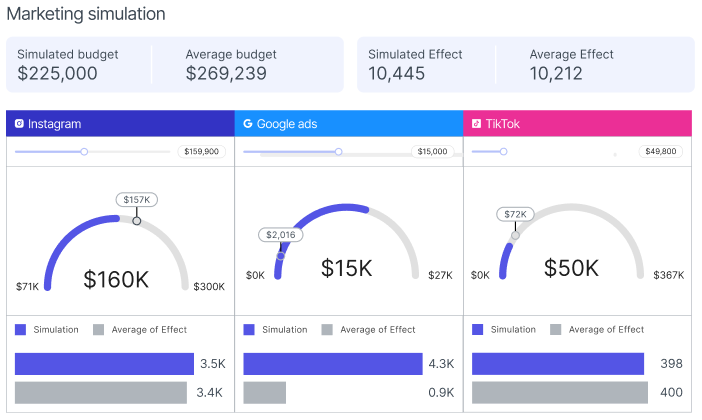Marketing teams’ resources are always limited. Today, with layoffs and budget cuts, your marketing team must use the tools, skills, and knowledge they have to make the most impact. Instead of relying on past performance or current hunches, they have to make forward-thinking marketing decisions to stay competitive. Artificial intelligence (AI) and machine learning (ML) can help, and they’re likely already ingrained in your marketing team’s workflows in one way or another. But is your team using them to their full potential? Predictive analytics combines data, statistics, and machine learning techniques to generate informed predictions about future outcomes. This AI-driven approach allows your team to maximize limited resources from the macro level of budget allocation down to the micro levels of campaign optimization. With predictive analytics, your marketing team can reach more ideal customers, with a budget of any size, to achieve great results even in the most challenging economic conditions.
The state of B2C marketing budgets
Economic uncertainty is a constant challenge in our lives today. A downturn seems to loom around the corner, and interest rate and market fluctuations are constant. Many businesses have cut spending and laid off thousands of workers. More than 7% of the 2022-2023 tech layoffs were marketers, according to a study by 365 Data Science. Those who are left behind — likely with smaller budgets and downsized teams — must continue to deliver the same results while navigating changing customer behaviors — or in other words, new customer demands and expectations. Since economic conditions affect consumers, products, and services differently, marketing teams must adjust their strategies to cater to their audiences. For example, people may cut subscriptions and scale back ecommerce purchases to save money. But more affluent customers may continue to buy luxury items and take expensive trips. It’s also more challenging to keep up with consumers in general. More than 70% of marketers feel meeting customer expectations is more demanding than in the past. The recent wave of strict data regulations isn’t helping. With the imminent loss of third-party cookies and evolving privacy policies of social media platforms and mobile devices, marketers must gather more first-party data (customer behavior) and zero-party data (customer input) to create effective campaigns.
Even though the status quo is anything but normal, marketers are still expected to plan and determine return on investment (ROI) for their campaigns. The pressure to justify existing projects and investments has dramatically increased. But with so many unknowns and limited visibility, marketers are having trouble forecasting results much further than a quarter out. In our State of Predictive Analytics in Marketing survey, we asked 250 marketing executives at companies with $100M minimum annual revenue to rank the difficulty of showing quantifiable ROI for campaign and channel performance. 100% found it challenging, with 55% of respondents saying the task is somewhat or a little challenging and 45% reporting it’s extremely or very difficult.
The usual approach to marketing budget planning
With the state of marketing budgets in disarray, your team members must find a way to get the most bang for their buck. Let’s start from square one and review the usual approach to planning. First, your marketing team decides which channels to invest in and how much money to allocate to each one. These choices include online channels (social media ads, paid search, etc.) and offline channels (direct mail, billboards, etc.). As your campaigns produce results for each channel, you evaluate outcomes to determine the best return on ad spend (ROAS). Finally, you make channel investments or divestments according to campaign performance. To make these critical decisions, your marketing team typically must wait for sufficient data. For example, after a campaign runs for seven days, Google Ads can provide data on customer value. But even at that point, a campaign that’s gaining momentum could fizzle out. Or a slow-start campaign might take off in the long term. There’s no clear indication of what the future holds. So despite having tons of data at their fingertips, many marketing teams rely on gut feelings and guesswork to predict customer behavior. They’d like to use AI-driven insights to make these predictions, but most don’t have those capabilities yet. Our predictive analytics survey asked marketing executives what was keeping them from using predictive analytics more often. Here’s what they said:
Your marketing team can overcome many of these data challenges with automation. In fact, 93% of marketing executives said they felt data scientists could solve more complex problems with low-/no-code, AI-powered predictive modeling tools. With a predictive analytics platform, you can connect to multiple data sources to automatically extract, prepare, and clean data. Then, auto machine learning (AutoML) builds and tests different predictive models to choose the best one based on the performance metric you’re targeting. Finally, predictions are automatically deployed into your business processes — along with monitoring and maintenance — to ensure return on value. But even with automation, your marketing team may still struggle to align your business needs and marketing goals with predictive model creation and maintenance. Before working with predictive analytics, you need a strategy to get the most out of these tools. Let’s look at what it’s like to include predictive models in your daily decision-making and marketing strategy.
How predictive analytics helps drive marketing budget decisions
Predictive analytics improves your marketing decisions by giving you insights into the future. With this data, you can predict likely customer outcomes, strategize campaigns effectively, and choose efficient ways to shape the future. Your marketing team can use predictive analytics for many use cases, such as:
- Customer-level predictions of future behavior
- Forecasting customer trends
- Forecasting purchasing behavior for priority segments
- Forecasting respondent-level purchasing behavior
- Customer segmentation
- Modeling to uncover insights
Here are three essential ways your marketing team can use predictive analytics: marketing mix modeling, campaign management with predictive lifetime value (pLTV), and campaign optimization with predictive events.
Marketing mix modeling (MMM) for budget allocation
Marketing mix modeling (MMM), also known as media mix modeling, uses a statistical method to analyze the data you receive from your marketing spend and outcomes. MMM operates at the channel level, so it’s beneficial when consumer data is unavailable. Let’s say your marketing team wants to examine revenue. MMM builds a statistical model to show you the amount of revenue you can attribute to each channel based on your historical data. This analysis lets you see your ROAS across the board, including online and offline channels. The model then looks ahead and predicts the results you can expect from various budget allocations. You can then use your MMM data to guide your actions toward a particular outcome. For example, if you want to increase revenue by $500,000 next year, the model can create a simulation with that amount and tell you which channels to invest in (and how much) to achieve that result. You can refresh the models each week or each month for ongoing budget optimization.
Pecan’s MMM solution reveals channel saturation and carryover effects, plus additional insights.[/caption] MMM also considers seasonality and can include other external data. It adjusts for and provides insight into important but hard-to-capture aspects of marketing outcomes, such as channel saturation. MMM can tell you when a channel’s ROI is expected to plateau so you can reduce spending and move money to a channel that hasn’t reached its saturation point yet. You can also determine the ongoing impact of brand equity – the value of your established brand name and reputation — and even the “snowball” effect of positive word-of-mouth about your brand. Before stronger computing powers and readily accessible data, it could take months to get refreshed results from marketing channels. Back then, MMM was a time-consuming and complex process. Only the biggest advertisers could take advantage of it. But now, automated machine learning and data preparation offer a faster, easier way for marketers to update their budgets as things change in real time. MMM gives your marketing team an enhanced view of the big picture. It provides better attribution of spending and outcomes — that’s more trustworthy and predictive — to reliably guide your budget planning for the long haul.
Predictive lifetime value (pLTV) for campaign management
Predictive lifetime value (pLTV) enables your marketing team to respond to constant shifts in consumer needs and demands. This method uses early campaign results to predict each customer’s pLTV. No more waiting seven days to forecast the success of a campaign. This predictive approach, driven by machine learning, shows how your campaigns will perform over time — well before the end of a week. Predictive models forecast how much revenue customers will generate during a campaign with data from the first 24 to 48 hours. Early knowledge of their pLTV allows you to decide whether to end a campaign before you waste thousands of dollars in ad spend or invest more in a campaign that will yield greater ROI down the road. Here are the basics of how pLTV works. Algorithms project the likely future value of your current customers. These values are based on certain characteristics from the data you have about them. Predictive analytics identifies patterns in the behaviors of customers with various lifetime values, then uses that information to predict the future lifetime value of your potential customers in your audience. ML models built from your existing data predict pLTV based on factors such as engagement, app or website visits, and purchases. When you know a customer’s pLTV, you can figure out how much money to spend on acquisition — while ensuring that cost is lower than their predicted value. With this information, you can focus resources on campaigns that draw customers with the highest pLTV and boost the ROAS of those campaigns.
Pecan’s platform can predict the LTV of users or customers you’re gaining with a campaign so you can make the best decisions.[/caption] These insights help you determine the future ROAS of each campaign and choose which campaigns to optimize through personalization and nurturing. Granular predictions can also highlight critical nuances. For example, you can see if the campaign is performing poorly across the board. Maybe it’s underperforming in a specific geo or with a certain cohort. With this precise, ML-driven method, you can make confident marketing campaign decisions, reach your goals, and prove the value of your efforts. pLTV allows you to make more informed decisions about campaigns — faster. It gives you better guidance on which campaigns are worth the investment and which campaigns won’t be as viable.
Predictive events for campaign optimization
Predictive events help your marketing team target specific types of customers within individual campaigns. Once you verify a campaign is bringing in customers who align with your desired metric, you can send signals to the ad platform to target a similar audience. For example, let’s say your Facebook ad is converting high LTV customers. You can send a predictive event to the platform that indicates those customers are the kind you want to continue to target. Facebook can then seek more people with characteristics similar to those high LTV customers. These signals help you find ideal customers faster, spend more efficiently, and achieve ROAS goals quicker. To create predictive events, ML models analyze behavior patterns in your existing customer data to identify a specific kind of customer you want. Then, when new customers start engaging, they’re compared to those patterns to make predictions about their future behavior. You can choose which metric to base your comparisons on, such as pLTV, subscription conversions, and customer upsell and cross-sell. Not only can you find more of the customers you want, but you may also acquire them for less money. As competitors spend money to attract customers as soon as possible, you can forecast which customers will become more valuable in the future. At that point, you’ll have less competition and a lower cost.
Predictive events work on all your platforms, such as iOS, Google, and social media. These signals are instrumental when granular data is unavailable because of restrictions like Apple’s SKAdNetwork (SKAN) and App Tracking Transparency (ATT), as well as the upcoming changes to third-party cookies in Chrome and Android. With predictive modeling, you can regain much of the visibility into channel ROI that diminished because of SKAN. Predictive events fine-tune directives for ad platforms so they can find the type of customers you want to acquire based on high LTV or other metrics. These signals allow marketers to get a clearer picture of ideal customers’ behavior and future actions.
What’s possible with an AI-driven approach to your marketing budget
It doesn’t matter whether you use just one of these AI-powered methods or adopt the entire framework. Either way, you’ll discover a more efficient way to spend your marketing budget and reach your targets faster. Here are a few examples of business outcomes from using predictive analytics solutions.
Success story: SciPlay
SciPlay is a global social and mobile game developer and publisher that creates popular social casino and casual games. Partnering with Pecan, the company put 18 months of historical data from a U.S.-based social casino game into an AI-powered MMM predictive model, which determined revenue from new game installs on the network and channel levels. The model discovered two critical areas for SciPlay to investigate further. First, it found the most effective marketing channels accounted for less than 20% of their ad spend and weren’t being optimized. Second, the company could tell which channels were saturated (or close to it) and would not benefit from further investment. As a result, SciPlay decreased its per-channel budget without negatively impacting the channels’ revenue contribution.
Success story: Hydrant
Hydrant is a wellness brand that sells drink mixes through its ecommerce channel and retail partners. Pecan helped the company develop and implement a predictive model to analyze thousands of customers’ purchase history spanning 180 days. The model predicted each customer’s likelihood to churn. The model’s accurate predictions aligned with the future behavior of Hydrant customers. With this knowledge, Hydrant focused its marketing efforts on customers who were predicted to buy again. Pecan’s predictions resulted in a higher winback rate in A/B testing. Customers predicted to have the lowest chance of purchasing again were sent targeted offers. That group had a 2.6x higher conversion rate and a 3.1x higher average revenue per customer than a control group. Partnering with Pecan has helped Hydrant more accurately understand customers’ future behavior to optimize marketing spend and plan proactively.
Maximize your marketing budget with Pecan AI
It’s time to move away from making marketing budget decisions based on the past and start making data-driven decisions focused on the future. An automated approach to predictive analytics makes it simple to generate impactful predictions your marketing team can start using right away in its marketing strategy. With Pecan AI, you have the power to break through the limits of traditional approaches to business intelligence and data science. Start seeing the benefits of accurate, reliable, relevant predictive models on a far shorter timeline than in typical data science projects. Our accessible, low-code solution automatically:
- connects to and combines your data;
- customizes models to match your key performance indicators (KPIs); and
- integrates predictions into your existing systems for immediate action.
All that without having to rely on data scientists or external resources — your marketing team can take this on with your analysts’ skills and see results in a few weeks, not months. Watch how Pecan AI removes the guesswork from your growth and makes your data more valuable. Schedule a live demo today!










